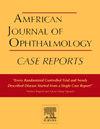Immediate sequential corneal allogeneic intrastromal ring segment transplantation and cataract surgery
Q3 Medicine
引用次数: 0
Abstract
Purpose
To report the combined approach of corneal allogeneic intrastromal ring segment (CAIRS) transplantation and cataract surgery in a cataract patient with corneal ectasia.
Case report
A 75-year-old male presented with age-related corticonuclear cataract, high myopia, and corneal ectasia on his right eye. After detailed discussion of treatment options, the patient wished to undergo a combined approach of CAIRS procedure and cataract surgery on his right eye. A femtosecond-laser (Wavelight FS200, Alcon, USA) was used to create a corneal pocket at mid-stromal depth and incision at 190°. Then, cataract surgery was performed with a 2.5-mm corneal incision, manual capsulorhexis, and phacoemulsification. A 3-piece intraocular lens (IOL) with a dioptric power of 0 diopter (D) (target refraction: −3.0 D) was implanted into the capsular bag. After cataract surgery, an 8-mm CAIRS tissue with 160° arc and 500 μm thickness was inserted (KeraNatural, VisionGift, USA) into the stromal pocket. Follow-up examination at 3-months postoperatively demonstrated improved uncorrected (UDVA) and corrected distance visual acuity (CDVA), topographic parameters, as well as high satisfaction rate.
Conclusions
Our case report shows that an immediate sequential CAIRS transplantation and cataract surgery may be a viable option in managing cataract patients with corneal ectasia.
即刻序贯角膜异体间环段移植与白内障手术
目的报道角膜异体间环段(CAIRS)移植联合白内障手术治疗一例伴有角膜扩张的白内障患者。病例报告一名75岁男性,因右眼年龄相关性皮质核性白内障、高度近视及角膜扩张而就诊。在详细讨论了治疗方案后,患者希望接受cair手术和右眼白内障手术的联合治疗。使用飞秒激光(waveight FS200, Alcon, USA)在角膜间质中深度和190°切口处创建角膜袋。然后行2.5 mm角膜切口白内障手术,手工撕囊和超声乳化手术。将屈光度为0(目标屈光度为- 3.0 D)的3片人工晶状体(IOL)植入囊袋。白内障手术后,将直径为160°圆弧、厚度为500 μm的8mm CAIRS组织(kerannatural, VisionGift, USA)插入基质袋。术后3个月随访,未矫正视力(UDVA)、矫正距离视力(CDVA)、地形参数均有改善,满意率高。结论1例病例报告显示,即刻序次cair移植联合白内障手术是治疗伴有角膜扩张的白内障患者的可行选择。
本文章由计算机程序翻译,如有差异,请以英文原文为准。
求助全文
约1分钟内获得全文
求助全文
来源期刊

American Journal of Ophthalmology Case Reports
Medicine-Ophthalmology
CiteScore
2.40
自引率
0.00%
发文量
513
审稿时长
16 weeks
期刊介绍:
The American Journal of Ophthalmology Case Reports is a peer-reviewed, scientific publication that welcomes the submission of original, previously unpublished case report manuscripts directed to ophthalmologists and visual science specialists. The cases shall be challenging and stimulating but shall also be presented in an educational format to engage the readers as if they are working alongside with the caring clinician scientists to manage the patients. Submissions shall be clear, concise, and well-documented reports. Brief reports and case series submissions on specific themes are also very welcome.
 求助内容:
求助内容: 应助结果提醒方式:
应助结果提醒方式:


